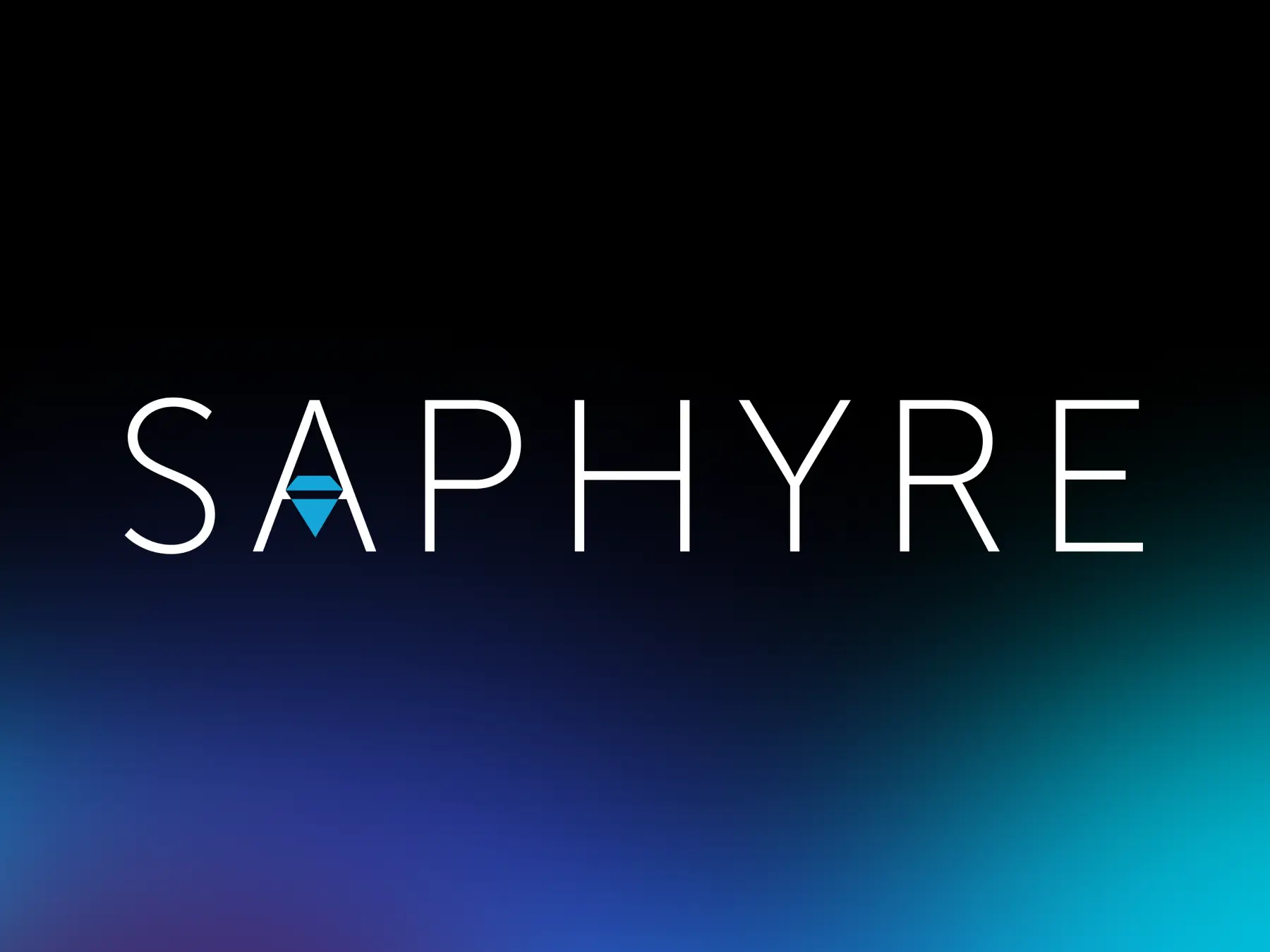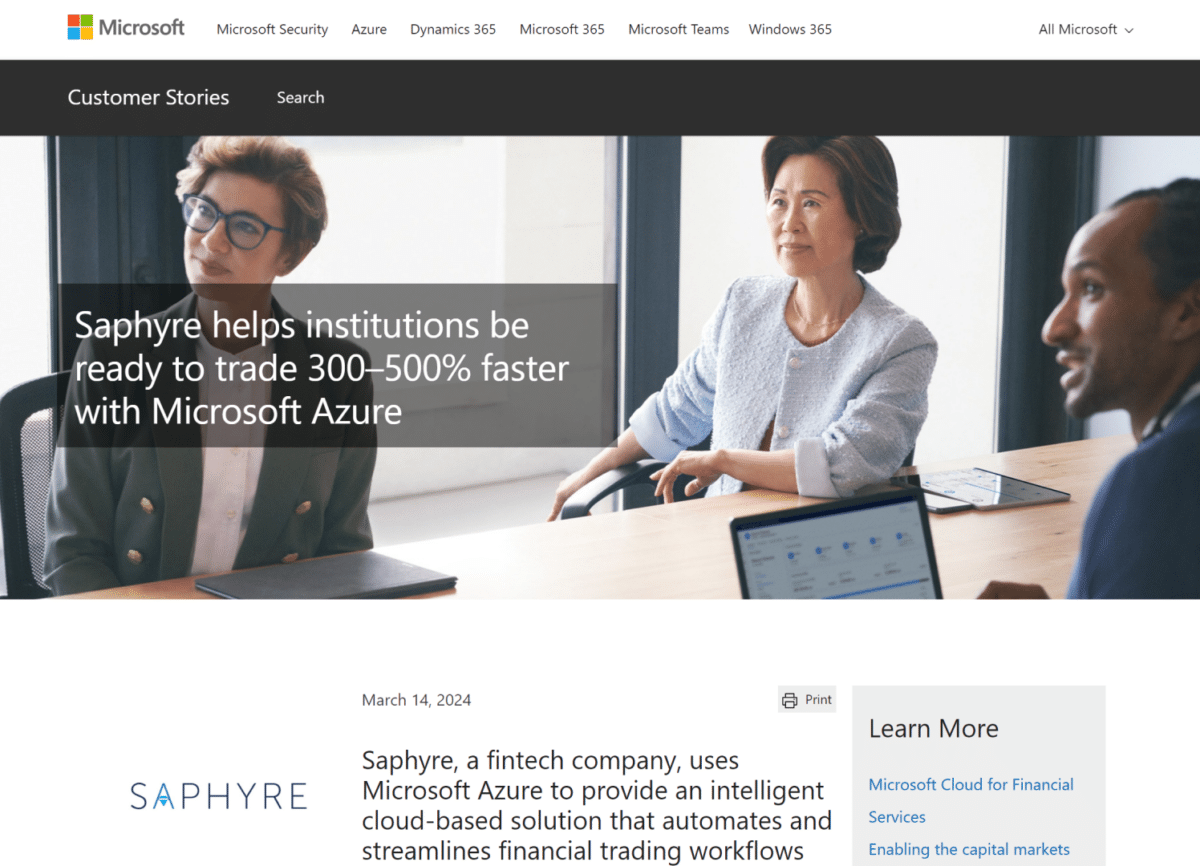






Saphyre, a fintech company, uses Microsoft Azure to provide an intelligent cloud-based solution that automates and streamlines financial trading workflows around client and counterparty life cycle management. Using Azure, Saphyre transformed outdated and time-consuming processes burdened by email and faxes, including account onboarding and maintenance and trade exception handling. Saphyre uses AI, automation, and networking to save time and effort in pre-trade, make T+1 compliance possible, support efficient information and document management, and secure counterparty collaboration. It also reduces post-trade settlement issues and customers’ manual efforts by 75%, helping clients to be ready to trade up to five times faster.
Financial market trading is a complex process. Financial organizations must manage a constant stream of trading activities, information, and documents—often across disparate and globally distributed teams and clients. Saphyre provides financial organizations with an intelligent, cloud-based solution that transforms outdated, manual, and time-consuming processes with automation, AI, and a networked platform.
Saphyre uses Microsoft Azure to manage data efficiently and securely with an enterprise-grade, cloud-based solution. Since its inception, Saphyre has worked with Microsoft to deploy its solution to top global financial organizations. Saphyre has helped these organizations save time and resources, improve service delivery and customer satisfaction, reduce regulatory compliance issues, and ultimately, be more competitive.
Many large financial institutions and investment firms find it challenging to manage trade data from thousands of clients. Manually entering client information is time-consuming and prone to errors during data transfer. “When working with these firms, I observed that some of the data was not standard across different financial institutions and platforms,” says Gabino Roche Jr., Chief Executive Officer of Saphyre.
Any institution looking to trade on a fund must perform a series of tasks before they can be ready to trade. These include setting up an account with legal entity information, trading instrument types, and tax information, as well as satisfying a credit review and completing Know Your Customer due diligence. In the past, these activities were primarily completed by email or fax between trading parties and their service providers.
This data exchange happens in pre-trade, but much of that information must be used again in post-trade. Any erroneous, missing, or changed data during the fund’s life cycle could cause trade delays, security issues, or revenue losses. Saphyre was founded to address this vulnerability.
In 2017, Gabino Roche Jr. founded Saphyre to create a real-time client account reconciliation and management solution between all institutional parties to a trade. Saphyre created patented technology that remembers established relationships, manages data and documents between trade parties, and secures data from outsiders.
Saphyre started with new account onboarding, the gateway for firms to generate new revenue. Customers quickly adopted Saphyre’s technology, and in 2021, Saphyre launched its solution to all parties in financial markets, including buy-side asset managers, sell-side brokers, custodians, and trading platforms.
From the beginning, Saphyre worked with Microsoft to create its solutions. “Working with financial institutions globally, there’s a lot of trust in Microsoft,” says Roche. “Microsoft is available everywhere, which is a big deal for these firms.” Using its cloud-based technology built on Azure and Microsoft security solutions, Saphyre is poised to support institutions through major changes coming to the trade market soon.
In May 2024, the United States and Canada will require all securities transactions to be settled within 24 hours. This new requirement, T+1 (time of trade plus one day), heightens the need for institutions to automate and streamline processes to settle transactions within the given window.
This change has caused many financial institutions to recognize an opportunity to upgrade and modernize processes to work more efficiently with multiple clients. “Investment firms and institutions might have the technology, but their clients don’t,” says Roche. “They need to be on the same page with them, and Saphyre’s real-time technology using Azure in the cloud can help with that.”
Saphyre has also recently joined forces with the London Stock Exchange Group (LSEG), a strategic partner of Microsoft, to create a richer environment for technological change by digitizing account onboarding and maintenance for all of LSEG’s FXall clients. These relationships will prepare trading platforms and financial firms to quickly adapt technology to meet new challenges and opportunities.
Saphyre used Azure to create a cloud-based solution for investment firms and service providers seeking to perform trades efficiently. In this model, clients only need to enter their data once. Saphyre stores that data in the cloud, maps it to the appropriate trading relationship, and uses AI models to recall it—expediting trades and processes.
This model also makes it easier for clients or institutions who want to transition to another broker or custodian or trade with a different counterparty. “Using Azure, we’re reconciling account information in real time for all parties,” says Roche. “We’re not just collecting data; we’re remembering it in perpetuity.”
This solution has helped Saphyre’s clients reduce manual paperwork, such as email exchanges or document faxing, by 75%. By working in tandem with a platform on which Saphyre can build solutions to address new challenges, it positions its clients to be ready for anything.
To strengthen its security posture and protect both financial institutions and clients, Saphyre also uses Microsoft Defender for Cloud, bolstered by the analytics capabilities of Microsoft Sentinel. The company relies on Microsoft Intune and Microsoft Purview to manage endpoint security and data compliance, respectively. “In addition to Azure, we layered on Microsoft security products,” says Michael Brandi, Chief Information Officer of Saphyre. “These technologies help Saphyre serve global enterprises with a small team.”
By sharing data more securely, clients can be ready to trade three to five times faster compared to manual onboarding, increasing revenue opportunities by completing trades more quickly and at better prices. “We’re helping create a revenue model on the back of streamlining their operations because we completely digitize that process,” says Roche.
Moving forward, Saphyre will continue helping clients streamline pre-trade fund onboarding. “If clients share pre-trade data with Saphyre, they can do one reconciliation and don’t need multiple post-trade processing steps,” says Roche. “We’re solving tomorrow’s trade processing issues today by remembering and structuring pre-trade data.”
Saphyre’s goal is to create a world in which trades happen in real time to provide clients with more revenue opportunities. “Saphyre is mapping data relationships, remembering them, intelligently building AI around them, and making that available to all,” says Brandi.
About Saphyre
Saphyre leverages patented AI technology to digitize all pre-trade data and activities across multiple counterparties: from asset owners to investment managers, hedge funds to prime brokers, any client firms to broker-dealers and custodians, and much more. Saphyre’s platform maintains memory of data and documents, resulting in clients not having to search or resubmit information, and expedites flow in a digitally structured manner so that it can be consumed and understood by any permissioned counterparty in the finance industry. This allows firms not only to assess risk faster but they can speed their onboarding processes, get real-time ready-to-trade statuses per account, and eliminate 70%-75% of redundant or inefficient post-trade activities.